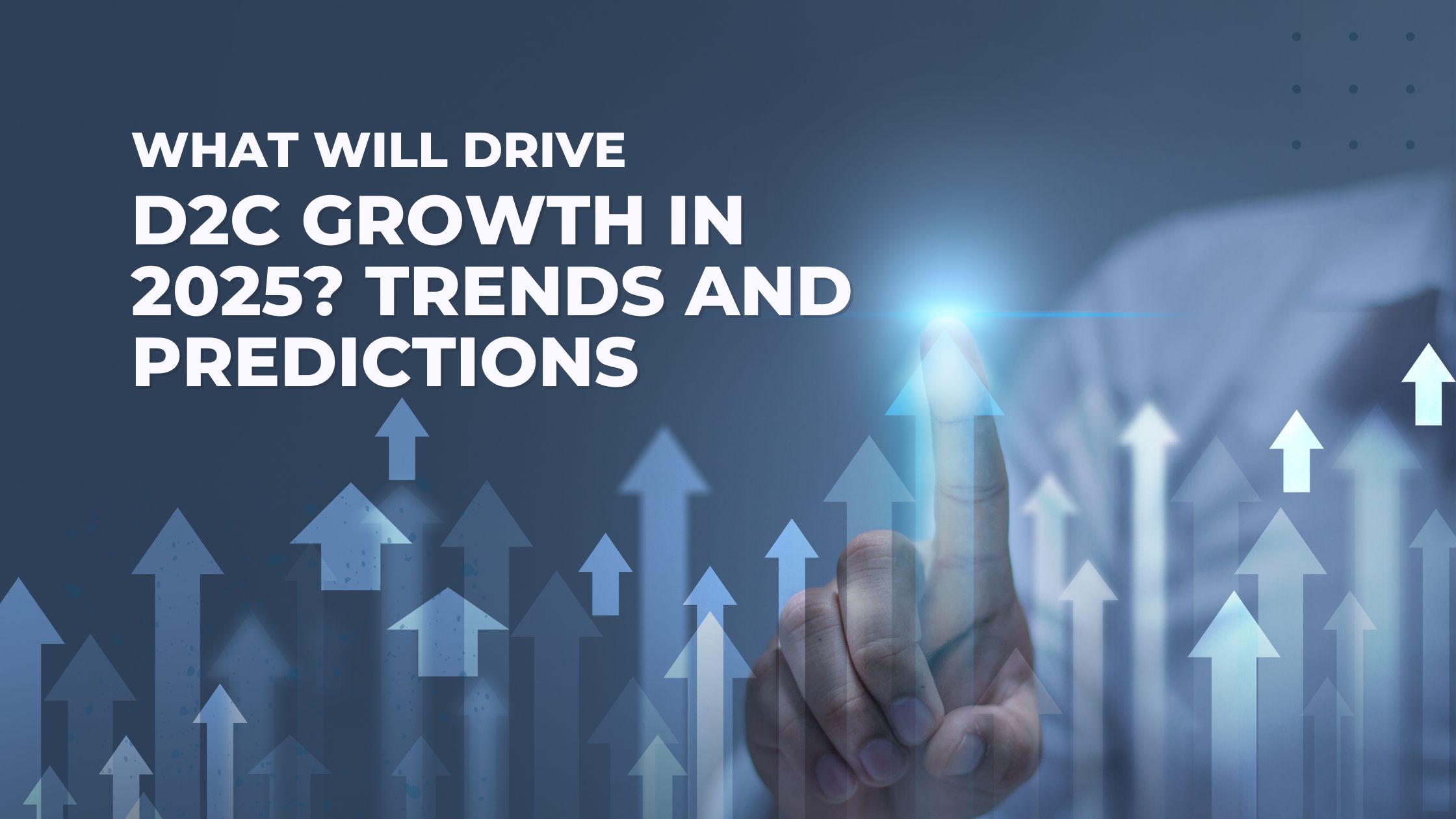What Will Drive D2C Growth in 2025? Trends and Predictions
The Direct-to-Consumer (D2C) model has revolutionized the way brands connect with their customers. No longer reliant on traditional retail channels, businesses can now engage consumers directly and build lasting relationships. This shift not only empowers companies but also gives consumers a more personalized shopping experience. As we look ahead to 2025, the landscape of D2C growth is poised for significant transformation.
With rapid advancements in technology and changing consumer behavior, understanding what drives D2C growth in 2025 becomes essential for brands aiming to stay competitive. From innovative marketing strategies to enhanced online shopping experiences, multiple factors will shape this dynamic sector’s future. Join us as we explore current trends and predictions that will define D2C growth in the coming years.
Current State of D2C Market
The direct-to-consumer (D2C) market has experienced significant evolution in recent years. Brands are increasingly leveraging digital platforms to connect directly with their customers, bypassing traditional retail channels.
This shift has opened up new opportunities for businesses of all sizes. Startups and established brands alike are embracing the D2C model to create personalized shopping experiences.
Recent data shows that more consumers prefer buying directly from manufacturers rather than third-party retailers. This trend is reshaping consumer behavior and expectations.
Social media and e-commerce integration have become vital elements in driving sales. Brands can now engage audiences through targeted content while simplifying the purchase process.
Moreover, sustainability consciousness is influencing purchasing decisions. Many consumers actively seek out D2C brands that prioritize eco-friendly practices and transparency in their supply chains.
As competition intensifies, understanding customer preferences will be critical for those looking to thrive in this dynamic landscape.
Emerging Trends in D2C Industry
The D2C industry is witnessing a surge in personalization. Brands are harnessing data to create tailored experiences for their customers. This trend enhances customer loyalty and drives repeat purchases.
Sustainability is another key focus area. Consumers increasingly prefer brands committed to eco-friendly practices. From sustainable packaging to ethical sourcing, businesses that prioritize the planet will stand out in the crowded market.
Subscription models are gaining traction as well. They provide convenience and foster ongoing relationships with consumers. Brands offering subscription services can predict revenue streams more accurately while keeping customers engaged.
Social commerce is reshaping how products are marketed and sold online. Social media platforms have become vital sales channels, allowing brands to connect directly with their audience where they spend most of their time—on social networks.
Augmented reality (AR) technology is becoming mainstream within D2C companies, enhancing product visualization and improving shopping experiences for users across various sectors.
The Impact of Technology on D2C Growth
Technology is reshaping the D2C landscape. Innovations in e-commerce platforms enable brands to create seamless shopping experiences for consumers. Enhanced user interfaces and streamlined checkout processes are crucial.
Artificial Intelligence plays a pivotal role as well. From personalized product recommendations to chatbots handling customer inquiries, AI improves engagement and satisfaction.
Moreover, data analytics offers invaluable insights into consumer behavior. Brands can tailor their marketing strategies based on real-time feedback and trends. This adaptability fosters deeper connections with customers.
Mobile commerce continues to rise, pushing brands to optimize their websites for mobile users. With more people shopping on smartphones, responsive design is essential for capturing attention.
Social media platforms are evolving into powerful sales channels. Direct purchases through Instagram or TikTok allow brands to reach younger audiences effectively while driving instant conversions.
Factors Driving D2C Growth in 2025
Several factors are poised to drive D2C growth in 2025. One significant element is the shifting consumer preference for personalized experiences. Customers increasingly seek brands that understand their needs and offer tailored solutions.
Sustainability is another crucial factor. Eco-conscious consumers favor brands with ethical practices, pushing more companies to adopt sustainable sourcing and production methods.
The rise of social commerce will also play a vital role. Social media platforms are evolving into shopping hubs, allowing brands to connect directly with customers where they already spend time.
Data-driven decision-making can’t be overlooked either. Brands leveraging analytics will gain insights into consumer behavior, enabling them to refine strategies effectively.
The expansion of direct shipping options enhances convenience for consumers. Fast delivery times and hassle-free returns foster loyalty and drive repeat purchases in this competitive landscape.
Challenges Faced by D2C Brands and How to Overcome Them
D2C brands encounter several hurdles that can hinder their growth. One significant challenge is saturation in the market. With countless new brands emerging, standing out becomes increasingly difficult.
Customer retention also proves to be a tough nut to crack. Many consumers are fickle, often swayed by price or trends rather than brand loyalty.
Supply chain issues can disrupt operations and affect customer satisfaction. Delays in shipping or inventory shortages may lead to lost sales opportunities.
To tackle these challenges, D2C brands should focus on building strong relationships with their customers. Personalized marketing strategies can make consumers feel valued and more likely to return.
Investing in robust supply chain management technologies will enhance efficiency and reliability too. Adapting quickly to industry changes through data analysis will keep brands competitive as well.
Predictions for the Future of D2C
As we look ahead, the D2C landscape will likely shift dramatically. Brands that embrace personalization will capture attention and loyalty. Tailored experiences based on consumer behavior can create strong emotional connections.
Sustainability is expected to play a pivotal role. Eco-friendly practices may become non-negotiable for customers who prioritize ethical consumption. Companies aligning their values with those of conscious consumers could see significant growth.
The rise of immersive shopping experiences is also on the horizon. Augmented reality and virtual reality are set to redefine how customers interact with products online, providing a more engaging journey from consideration to purchase.
Data analytics will continue to be essential for success. Real-time insights into customer preferences and trends can drive smarter decisions, allowing brands to respond quickly in an ever-evolving market landscape. Adapting swiftly could make or break future D2C ventures.
Conclusion
The D2C growth in 2025 is poised to be transformative. As brands continue to bypass traditional retail channels, they will harness the power of technology and consumer insights like never before. The rise of personalized marketing, enhanced customer experiences, and sustainability initiatives will shape how consumers engage with D2C brands.
Emerging trends such as social commerce and subscription models will redefine the shopping experience. At the same time, leveraging data analytics for decision-making will become crucial for sustained success. However, challenges remain—competition is fierce, and navigating supply chain complexities can hinder progress.
To thrive in this evolving landscape, D2C brands must prioritize agility and adaptability. By embracing innovation while staying true to their core values, they can not only survive but flourish amidst changing consumer demands.
As we look ahead toward 2025, it’s clear that the future holds vast potential for those ready to embrace change within the direct-to-consumer model.



